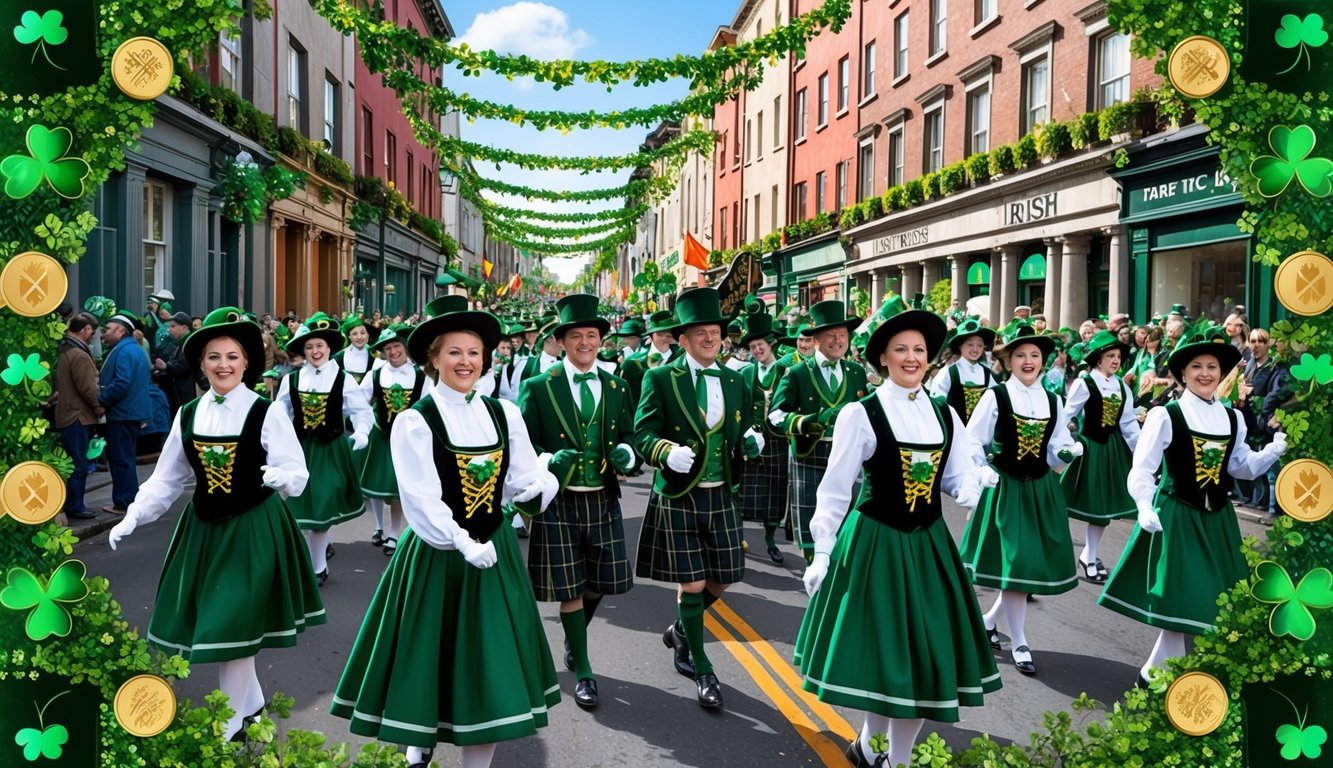Don’t Miss Out On This Unique Astrological Opportunity
Are you tired of spinning your wheels and getting nowhere? Simply put, you’re out of sync: you’re out of alignment with your astral configuration.
But: there’s a kind of map that can help you reclaim your alignment. Think of it as your own personal blueprint to success and happiness: a blueprint that will help you live your most amazing life.
Get started here.
Do you ever wonder why St. Patrick’s Day holds such spiritual importance? The celebration is more than just parades and wearing green. St. Patrick’s Day honors the spread of Christianity in Ireland, largely attributed to St. Patrick himself. He is believed to have used the shamrock to explain the Holy Trinity, blending Irish culture with Christian beliefs.
As you think about the festivities, consider the deeper spiritual significance. St. Patrick stands as a symbol of faith and resilience.
His journey reflects the impact of Christian teachings in Ireland, transforming it into a land with a strong religious identity.
This day is a chance to connect with Irish traditions, explore your own faith, and embrace the rich history behind the celebrations.
In Ireland, people often focus on prayer and reflection, remembering not just a man, but the faith he spread.
The wearing of green and shamrocks takes on new meaning when you think about its roots.
By understanding the spiritual aspect, you find more connection to the cultural and religious importance of St. Patrick’s Day.
The Life and Legacy of St. Patrick
St. Patrick is known for his significant role in the spread of Christianity in Ireland.
As the patron saint of Ireland, his story involves trials, transformation, and enduring contributions to the Christian faith.
Early Life and Captivity
St. Patrick was born in Britain, likely in the late 4th century, into a Romanized family.
His early life took a dramatic turn when he was kidnapped by Irish raiders at the age of 16 and brought to Ireland.
During his six years of captivity, he worked as a shepherd, a position that led him to deep personal reflection and a growing faith.
It was in captivity that Patrick experienced a spiritual awakening, finding comfort and strength in his Christian beliefs.
He managed to escape after receiving a divine message in a dream, instructing him to return home.
After his escape, Patrick had a second dream, calling him to return to Ireland as a missionary.
This set the stage for his journey to becoming a Christian missionary.
Missionary Work in Ireland
Patrick returned to Ireland with a mission to convert the Irish to Christianity.
His approach was marked by respect for the local customs and a deep understanding of Irish society.
He often used familiar symbols, like the shamrock, to explain Christian concepts, showing his adaptability and wisdom.
His missionary work faced challenges, but he was determined and brave.
Patrick established many churches and baptized thousands of people, significantly advancing Christianity in Ireland.
His efforts helped form a strong Christian presence that shaped the religious landscape of the country, earning him the title of patron saint of Ireland.
St. Patrick’s Death and Sainthood
St. Patrick died on March 17th, traditionally believed to be in the year 461 AD.
After his death, he was celebrated for his role in bringing Christianity to Ireland, and March 17th is now celebrated globally as St. Patrick’s Day.
This day honors both his life and his influential legacy.
Patrick’s sainthood wasn’t formalized by the Vatican as the practice of canonization started after his time.
However, his impact as a spiritual leader and the patron saint has endured through time.
His legacy continues to inspire, emphasizing themes of faith, conversion, and resilience in the face of adversity.
Symbols and Traditions of the Day
St. Patrick’s Day is filled with rich symbols and traditions.
Many of these practices have roots in Christianity and Irish culture, providing a meaningful backdrop to the festivities.
The Shamrock and the Holy Trinity
One of the most well-known symbols is the shamrock.
According to tradition, Saint Patrick used this three-leaf clover to explain the concept of the Holy Trinity to the Irish people.
Each leaf represents an aspect of the Trinity: the Father, the Son, and the Holy Spirit.
This simple plant carries deep meanings in Christian teachings and is celebrated as an icon of the day.
Today, you might see shamrocks everywhere, from parades to decorations, symbolizing both St. Patrick’s teachings and Irish pride.
This rich history ties together religious significance and cultural heritage.
The shamrock remains a powerful emblem that links Irish identity with Christian beliefs.
The Color Green and the Emerald Isle
The color green is another key aspect of St. Patrick’s Day.
This color is deeply linked to Ireland, often referred to as the “Emerald Isle” due to its lush, green landscapes.
Wearing green on this day is said to bring good luck and protect you from leprechauns, mischievous creatures in Irish folklore.
In addition to its association with leprechauns, green represents the rolling hills of Ireland and the Irish people themselves.
Many cities around the world mark St. Patrick’s Day by lighting up landmarks in green, creating vibrant displays.
This visual tribute serves as a reminder of the connection between the holiday and Ireland’s natural beauty.
Celebration of Irish Heritage
Celebrating Irish heritage is central to St. Patrick’s Day.
This day provides an opportunity for people of Irish descent all over the world to connect with their roots.
Parades and festivals are common, featuring traditional Irish music, dance, and food.
Participants often dress in green, don shamrocks, and embrace symbols like leprechauns.
These festivities not only celebrate Irish culture but also its history, customs, and shared identity.
People gather to honor their lineage and the enduring legacy of St. Patrick.
By participating in these traditions, you join a global community that cherishes both the spiritual and cultural aspects of this beloved day.
Spiritual Essence and Moral Messages

St. Patrick’s Day isn’t just about wearing green; it holds deep spiritual meanings.
It focuses on themes of faith, hope, love, forgiveness, renewal, gratitude, and community.
These elements guide your spiritual journey and help you reflect on important values.
Themes of Faith, Hope, and Love
Faith, hope, and love are central to St. Patrick’s story. St. Patrick is famously known for bringing Christianity to Ireland.
Through this, he instilled faith among the people.
Hope was crucial as he faced many challenges but never gave up on his mission.
Love, especially for the Irish people, fueled his spiritual journey.
Remember that these three pillars guide your life too.
Faith helps you trust in God’s plan.
Hope encourages perseverance during tough times.
Love, as taught by Christianity, reminds you to practice acts of kindness and empathy towards others.
Lessons of Forgiveness and Renewal
St. Patrick taught lessons of forgiveness rooted in his own experiences.
As a former slave in Ireland, he returned to share Christianity with his captors.
This act of forgiveness is powerful, showing you that holding onto anger only harms you.
Renewal is also a key lesson.
Coming back to Ireland signified a fresh start for him.
Embracing forgiveness paves the way for spiritual renewal.
You can find this sense of renewal through prayer, reflection, and genuine acts of kindness, freeing yourself from past burdens.
Gratitude and Community
Gratitude plays a big role on St. Patrick’s Day.
When you practice gratitude, you acknowledge the blessings in your life.
This day encourages you to give thanks for your spiritual growth and for the community around you.
The celebration fosters a sense of belonging.
It brings people together, reminding them of the strong sense of community St. Patrick helped build.
Your involvement in your community reflects his teachings, offering support, sharing joy, and creating bonds that strengthen your faith.
Gratitude helps you see the value in the love and support of those around you.
Cultural Impact and Celebration

St. Patrick’s Day is a vibrant celebration filled with music, food, and parades.
It’s a day when people honor Irish culture and heritage with joyful festivities across the globe.
St. Patrick’s Day Around the World
Each year on March 17th, people around the world celebrate St. Patrick’s Day with parades and lively events.
In places like Dublin, the streets come alive with music and colorful costumes.
In the United States, cities like Boston and Chicago go all out with Irish-themed events.
Chicago even dyes its river green! These celebrations bring together people of all backgrounds to enjoy the holiday’s blend of history and fun.
Irish Food and Festivities
Food plays a central role in St. Patrick’s Day celebrations.
You might find yourself enjoying traditional dishes like corned beef and cabbage or Irish soda bread.
Many people also indulge in hearty stews or shepherd’s pie, embracing the rich flavors of Irish cuisine.
For those observing Lent, finding no meat Friday recipes can be important, leading to delicious alternatives like potato leek soup or beer-battered fish.
No matter the dish, food brings people together to celebrate Irish heritage and tradition.
These meals often bring family and friends together, reflecting the spirit of community and joy.
Sometimes, people might also explore other Irish recipes or create their own festive dishes to share.
Music, Dance, and Parade
Music and dance are at the heart of St. Patrick’s Day celebrations.
Festivals often feature lively Irish folk music, paired with traditional dancing.
You may see step-dancers skillfully moving to the rhythm, creating a cheerful and energetic atmosphere.
Parades filled with dancers, musicians, and colorful floats take over the streets, captivating onlookers of all ages.
Participating in or watching these events can be an exciting way to immerse yourself in the culture and traditions of Ireland.
Reflecting on the Spiritual Journey

Saint Patrick’s Day offers a unique opportunity to explore personal and spiritual growth.
Through reflection and tradition, it’s a time where you can focus on inner strength, hope, and your connection to faith.
Personal Growth and Self-Discovery
Saint Patrick’s Day is not just about wearing green.
It’s a journey inward, exploring who you are and your beliefs.
Personal growth involves examining emotions, actions, and how they align with your faith.
This is rooted in the story of Saint Patrick himself.
Taken as a slave, his struggles led to hope and newfound faith.
Encouraging self-discovery, this holiday allows you to evaluate your path.
Are you embracing qualities such as kindness, peace, and empathy? Reflecting on these traits can help you grow in your personal and spiritual life.
You can also attend religious services, seeking guidance and inspiration from the Gospel.
Additionally, consider learning about the unsung heroes of Christian faith, those who have quietly lived out their beliefs with unwavering devotion.
Their stories can serve as powerful examples, inspiring you to embody the virtues of humility and service.
By following their lead, you can strengthen your faith and positively impact those around you.
The Quest for Spiritual Growth
As you celebrate Saint Patrick’s Day, consider the quest for spiritual growth.
It’s a time to think about transformation and connecting deeper with your faith.
The story of Saint Patrick is marked by resilience and spreading Christianity throughout Ireland.
His journey symbolizes transformation through spiritual growth.
Embracing this path means seeking interconnectedness with others and the divine.
You find inner strength by tuning into spiritual meaning during this time.
Practices like prayer and meditation can deepen your connection to God.
These practices bring hope and optimism, important aspects of spiritual development.
By reflecting on the Virgin Mary prayer meaning, you can draw inspiration from her faith and devotion, strengthening your own spiritual journey.
This understanding fosters a sense of peace and guidance, helping you navigate life’s challenges with grace.
Through continuous prayer and reflection, you cultivate a heart centered on love, compassion, and divine wisdom.
By seeking solace in devotion, you open yourself to divine wisdom and patience, allowing faith to guide your path.
Reflecting on the prayer to St. Monica can provide encouragement in moments of struggle, reminding you of the power of perseverance and trust in God’s plan.
With a heart rooted in devotion, you nurture a deeper connection to your faith, finding strength and clarity through prayer.
Embracing these spiritual practices allows you to grow in faith and resilience, reinforcing your trust in divine guidance.
The prayer to St. Monica serves as a source of hope, reminding you that patience and unwavering belief can lead to blessings in difficult times.
Through steadfast devotion, you cultivate a sense of purpose and spiritual fulfillment, anchoring your heart in faith and love.
Connecting to the Divine Through Tradition
The traditions of Saint Patrick’s Day have rich spiritual significance.
Celebrating this day can connect you to the divine and reinforce your faith.
Attending church services and partaking in traditional meals are meaningful practices.
Sharing blessings can also be a part of this.
These practices offer a chance to observe and renew spiritual connections through tradition.
Tradition also brings a sense of community and belonging.
Sharing customs with others helps reinforce the bonds of your faith.
Participating in religious celebrations this week allows individuals to connect with family and friends, strengthening their shared beliefs.
These gatherings provide an opportunity to reflect on spiritual values and pass down meaningful practices to future generations.
Whether it’s through wearing green for luck or reenacting stories of luck and transformation, these practices remind you of the hope and faith central to Saint Patrick’s legacy.
Embrace these customs as a way to integrate spirituality into daily life.



